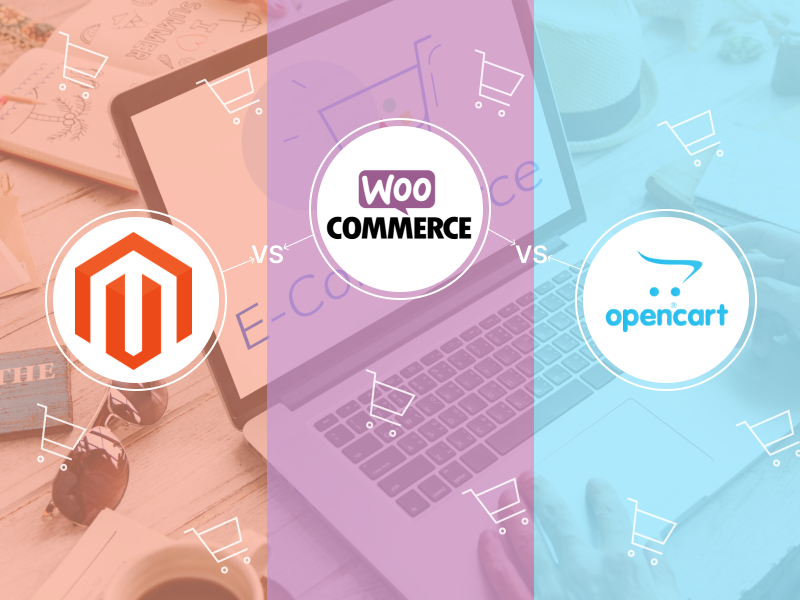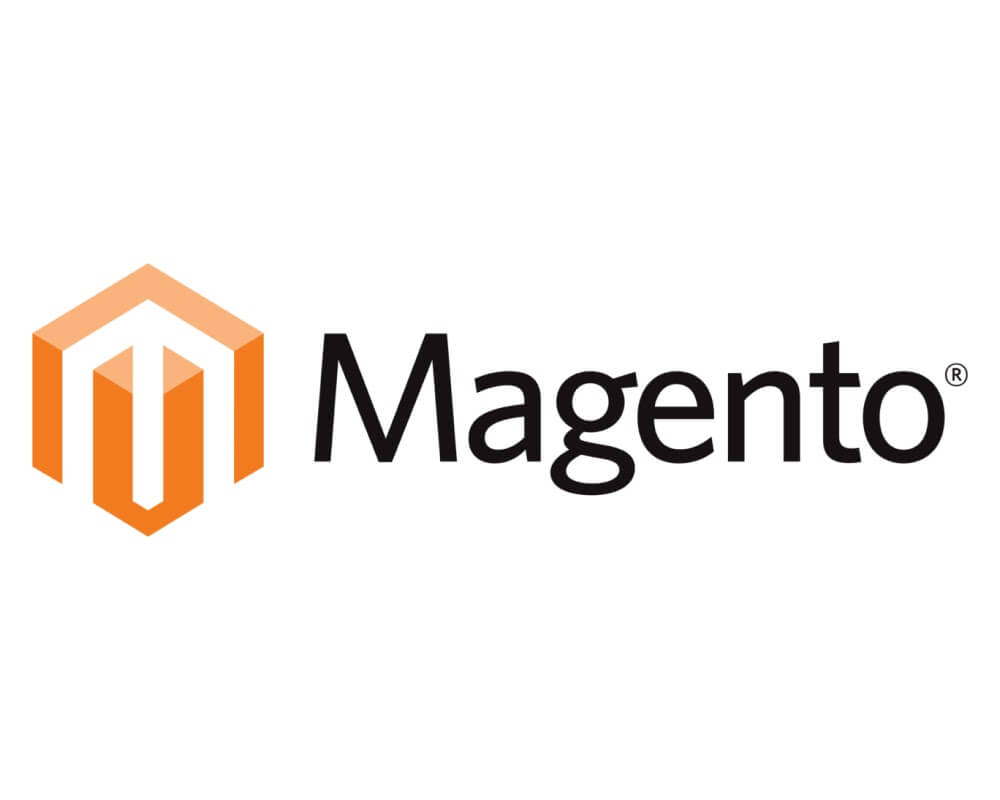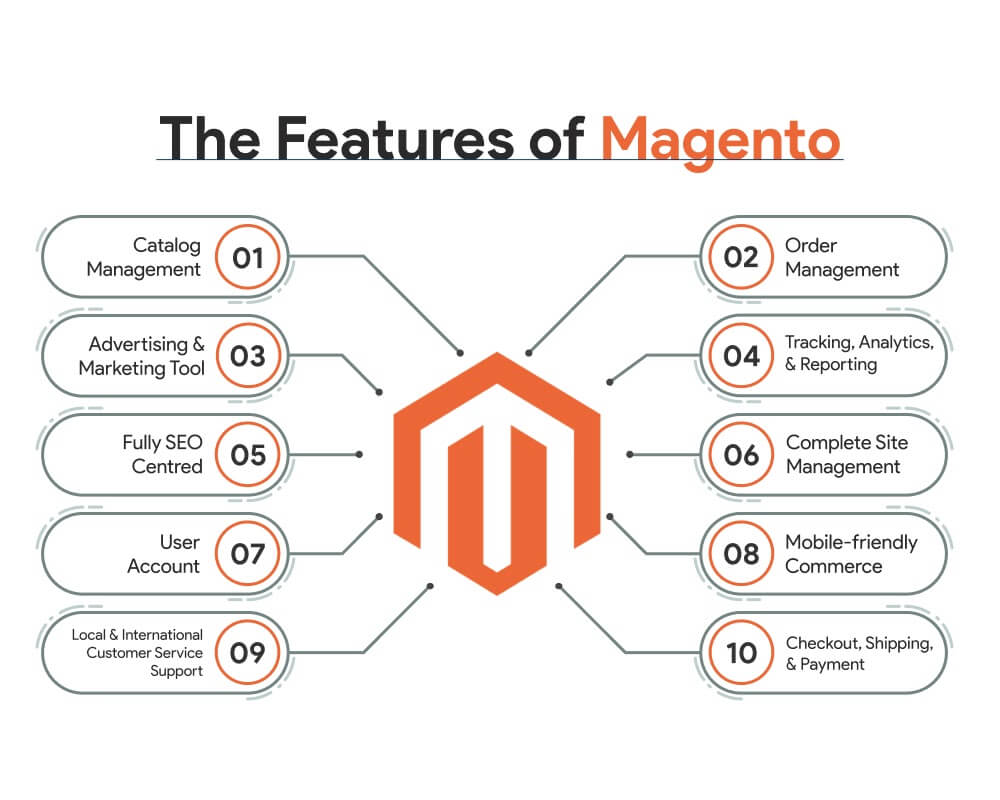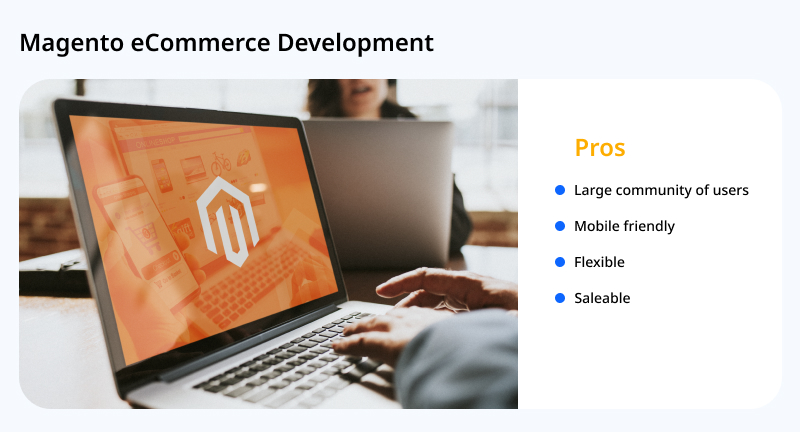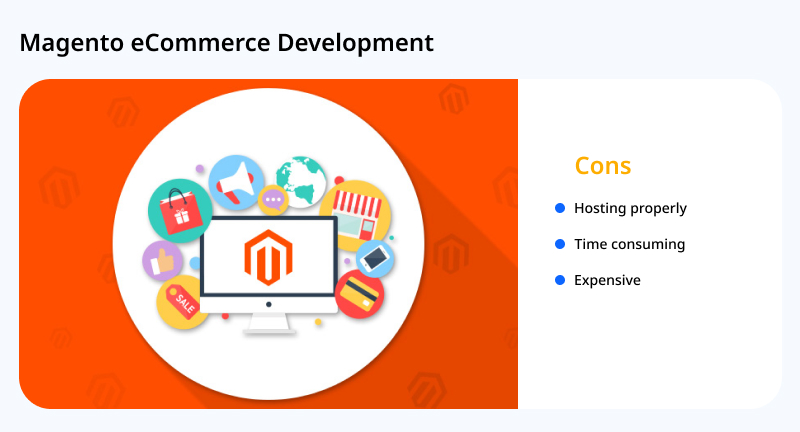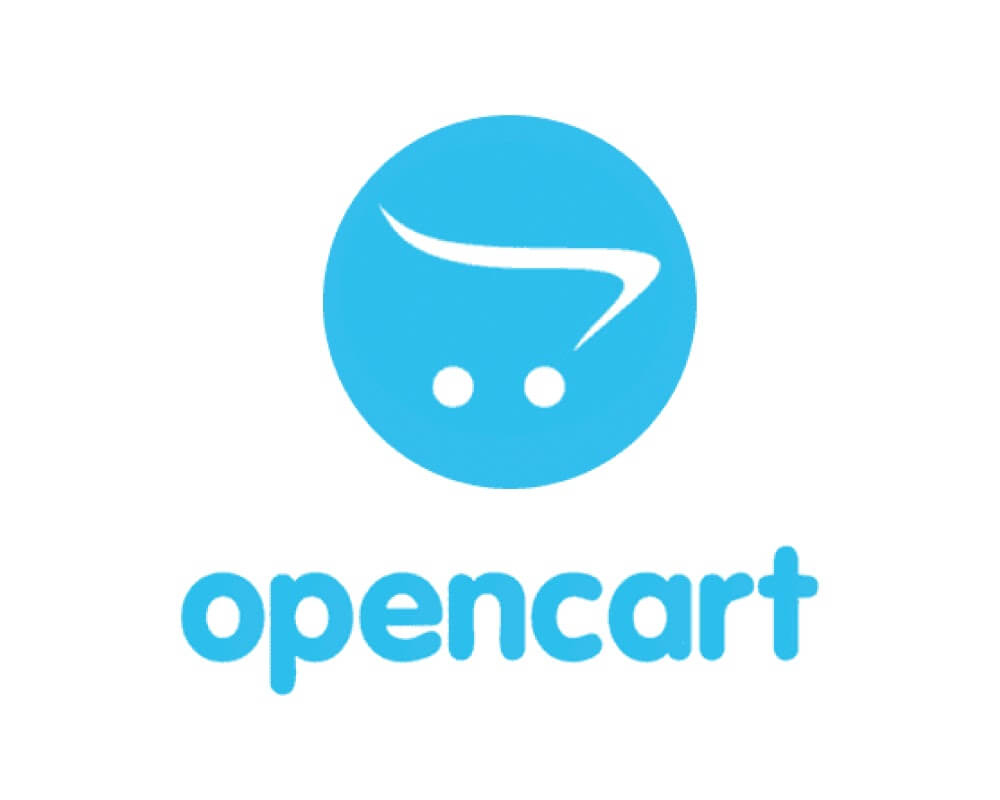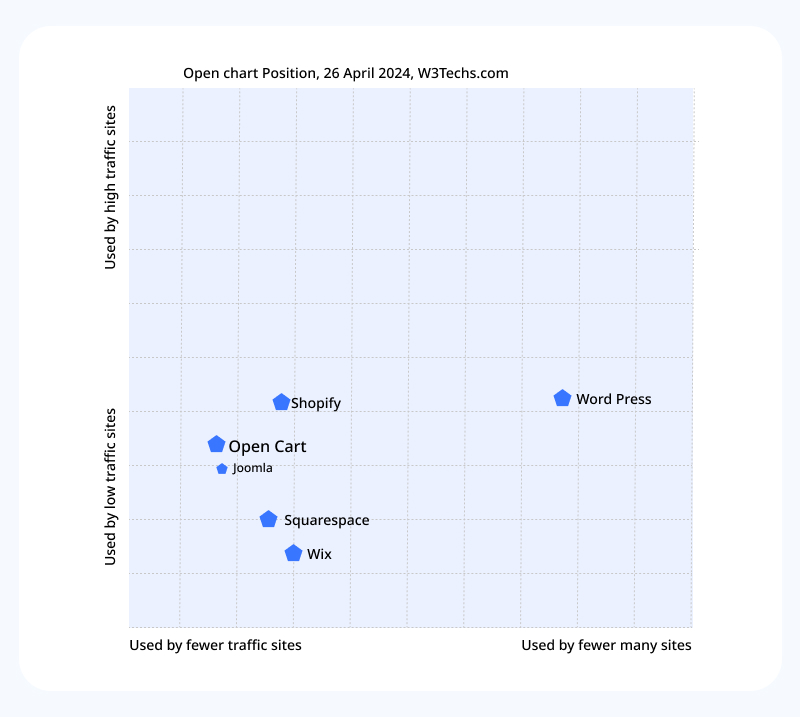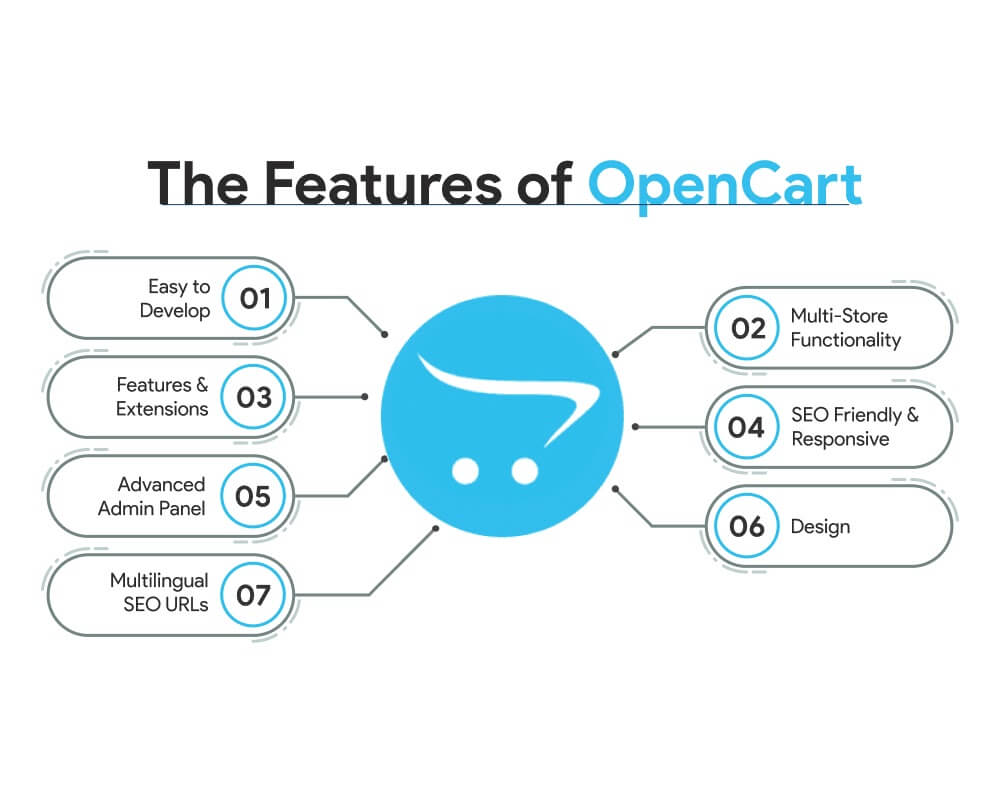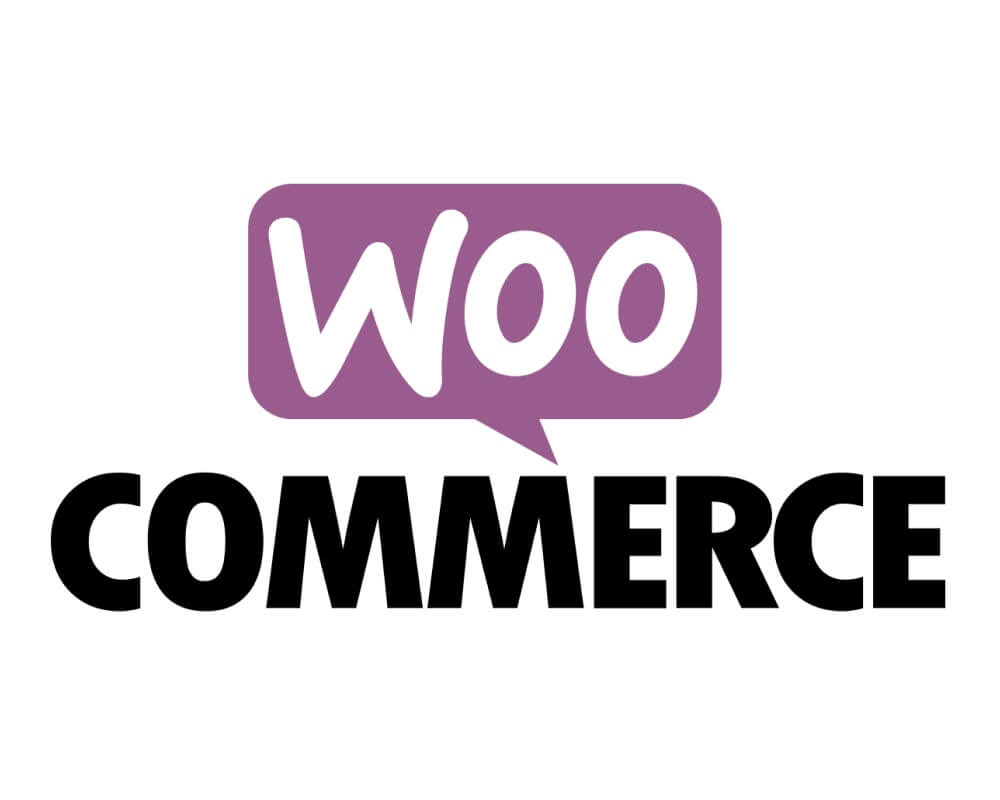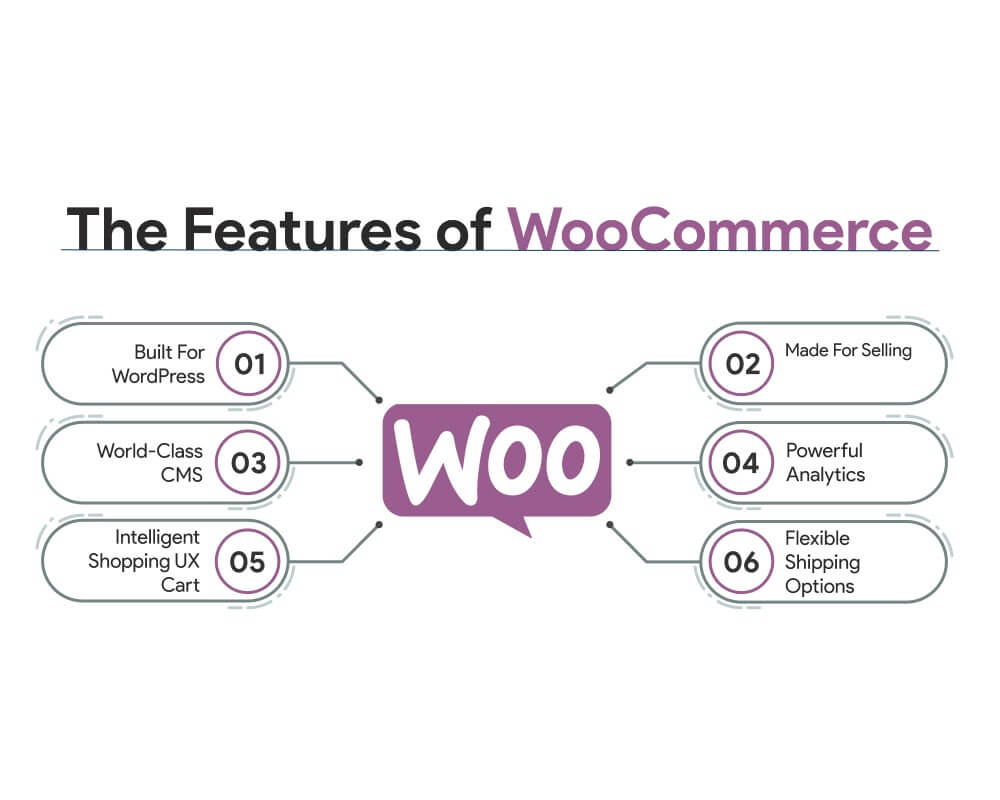What if I say you can get more sales without breaking the bank? Yes, it is possible with the help of eCommerce platforms. The good news is that the eCommerce sphere is not only rich in profits but also rich in operational and technological possibilities.
If you are not already using an eCommerce development platform, you are missing out on many potential customers and sales. And even if you use one, there is always room for improvement.
The key to success in eCommerce lies in finding the right platform for your business and making the most of its features. Many eCommerce platforms are available on the market, so it can be tough to choose the right one.
Choosing the optimal eCommerce platform is critical for online business success. This analysis compares three popular options: WooCommerce vs Magento vs OpenCart.
Table of Contents
What is Magento?
Roy Robin, in 2008, launched Magento – an open-source eCommerce platform built in PHP that offers online merchants a flexible shopping cart system and control over the website’s appearance, content, and functionality.
The platform provides search engine optimization, powerful marketing, and catalog-management tools.Millions of developers have used Magento for eCommerce development.
In 2018, Adobe took over Magento for $1.68 billion to develop its commerce loop. This acquisition also benefitted Magento and doubled its importance in the enterprise market.
Some Interesting Magento Statistics You Must Know
Magento has thrived since its release in 2008 because of its flexibility and user-friendly interface. As an eCommerce platform, it has allowed businesses to create online stores quickly and easily without expensive web development services. As per Save My Cent, here are some statistics on Magento usage:
- Magento is the 8th most popular eCommerce platform in the world.
- Magento powers 0.13% of all websites on the Internet.
- Magento is in fourth position as the most popular eCommerce technology among the top 100,000 websites.
- At least one of the three Magento versions is used by more than 170,000 websites.
- Magento-powered online stores expand three times faster than eCommerce sites powered by other platforms.
- Each year, Magento websites process $155 billion in gross merchandise volume (GMV).
- Migration to Magento 2 has proven to achieve a 165% return.
- There are about 5000 Magento extensions in the market.
The Features of Magento
Magento features list is comprehensive, and you will find everything generally needed in eCommerce website development. Below are the top cool features of the Magento e-commerce website development platform.
#1. Catalog Management
Whether you are selling clothing, accessories, beauty products, electronics, healthcare products, or anything else– a catalog is the key component of every e-store. Many Magento web development companies offers exclusive catalog management features that include:
- Allows digital products’ downloading– videos, music, images, etc.
- Supports virtual products
- Edit & delete product reviews easily
- Export & import products for batch update offline.
- Highly customizable options like resizing and watermarking
- Complete inventory management
- Attribute sets for fast product creation of various product types.
- RSS Feeds and lots more
#2. Advertising & Marketing Tool
With easy e-store management, Magento development also helps promote and market your products. There are lots of tools available that make your advertisement process easier, and these tools include:
- Monitor coupon usage, manage newsletters & polls
- Cross-sell products
- Offers free shipping and promotes new items list.
- Promotional pricing is restricted to some selected categories or products
- Option of distributing coupon codes across email, newsletter, and offline.
- Allows price variation based on quantity and groups
- Landing page tools for PPC, URL, new product promotional tools, etc
#3. Order Management
The popular Magento eCommerce development platform provides an unparalleled order management system. Users get a lot of options, including:
- View, create, edit and fulfill orders straight from the admin panel.
- Full call-center support, product configuration, and change.
- Aids in printing invoices, packing slips, and shipping labels.
- Allows multiple invoices, credit, and shipment memos per order.
- RSS feed, email notification, fresh orders, and more.
#4. Tracking, Analytics, & Reporting
Magento web development provides a lot of options for tracking, analyzing, and reporting. It includes the following:
- Google Analytics
- Sales & tax reports
- Total sales & refunded invoice
- Abandoned shopping cart & low stock report
- Product review report and more
#5. Fully SEO Centered
Magento development services provide comprehensive options that simplify your e-store search engine optimization. The SEO features include:
- Auto-sort popular searches and modifies
- Generates Google Sitemaps
- Supports SEO-friendly URLs.
- Easy to Meta-tag products and information
- Fast loading options like less usage of minimizes .css and .js files.
#6. Complete Site Management
Being one of the best eCommerce development platforms in the world, Magento understands the importance of complete website management. It allows multiple website controls within a single installation.
- Control the website from the admin panel and share only the required information.
- Fully customizable template design.
- Multiple language options and currencies.
- Tax rates based on product type, location, and group
- Integration between Magento and third-party apps
- Captcha-enabled websites and more.
#7. User Account
Magento development provides easy user account management options with many capabilities.
- Easy-to-understand account dashboard
- Save the wish list with comments
- Store unlimited address
- Recent orders history & status
- Newsletter subscription management
#8. Mobile-friendly Commerce
It’s one of the most excellent features of Magento website development that you’ll get. The platform allows website browsing or selected products customized, especially for mobile users.
- Open for Android, iPhone, & Mobile Opera browsers.
- Mobile HTML5 technology for developing mobile-friendly storefront
- Supports media files such as audio and video.
- Clear & user-friendly product display
- Swipe, zoom, & multi-touch
- Drag & drop etc.
#9. Local & International Customer Service Support
Magento eCommerce website development platform includes great back-end tools and a community for customer support.
- Contact Us form
- Local & international currencies and tax rates support
- Order tracking, history, and email updates
- Contains international website registration, shipping destination, and payment options.
- EU cookie notification and more.
#10. Checkout, Shipping, & Payment
Shipping and payment are the most important concerns for users when choosing a platform for shopping carts. Magento brilliantly includes a plethora of alternatives for shipping and payment options.
- One-page checkout
- Multiple orders shipment in a single order
- Shopping cart tax and shipping costs estimates.
- Integration with PayPal and other authorized online payment platforms.
- Full SSL security support for front-end/back-end orders.
- Free shipping, flat rate shipping, and order tracking.
Pros of Magento
#1. Magento has a Large Community of Users
As per Meetanshi, the Magento platform is downloaded 5,000 times a day. More than 239,000 live websites are using Magento (Adobe Commerce) platform. About 62% use Magento, while 38% use Magento 2.
As a result, you will always get instant support in case of any problem. Many resources are available today for the user’s assistance. This immense community support has inspired many retailers to hire a Magento eCommerce development company in India to develop a robust eCommerce website.
#2. Magento is Flexible
Magento is a flexible eCommerce platform that offers businesses a lot of authority over their online store’s look, feel, and functionality. Businesses can choose from a wide range of themes and plugins to create a unique shopping experience for their customers.
Magento also offers several customization options, so businesses can really make their store stand out from the competition. Furthermore, the Magento development service also allows third-party integration for different purposes, like product importing and more.
#3. Magento is Mobile-Friendly
Mobile-friendly configuration is always essential for eCommerce success. A recent survey shows around one-fourth of online customers shop via mobile. Though web browsing is no longer the trend, mobile-friendly websites have become another customer shopping platform.
Magento is mobile-friendly. You can quickly develop a mobile-friendly website that provides customers with the best possible shopping experience. This will significantly increase your sales and reduce your bounce rate.
#4. Magento is Scalable
While starting any business, we always have its future growth and expansion in mind. As the business grows, you should be competent in handling the increasing sales and products. It is the point where many e-commerce platforms are lacking today and hindering their business growth.
This is not the case with custom Magento development.
With Magento, you can easily manage the rising volume of sales and items. You will be surprised that the platform can support approximately 500,000 products and thousands of transactions in a single hour.
This unique benefit is not possible with other platforms like WooCommerce and OpenCart. You can easily customize your website.
However, if you are still new to or non-technical, you can hire Magento developers in India. They are available at a fractional cost and can fix your website bugs.
Cons of Magento
#1. Magento is Expensive
Today, many Magento versions are available. The community version is complimentary, while the business version costs approximately $15,000+. Additionally, the Magento team has explicitly developed Premium Enterprise for large businesses; it can strain your budget.
Also, add a third-party fee if you don’t know how to install its extensions. Thus, its price is a significant drawback. Otherwise, Magento is a popular eCommerce platform in the market, adding advancements to your website.
#2. Magento is Time-consuming
Magento has a slow loading time. Thus, customizations are becoming more challenging than other top eCommerce development platforms. You can’t easily switch from an existing website developed on the other CMS to Magento.
Its slowness is due to its flexible architecture, which makes the store setup process complex and time-consuming. Its poor speed is also highly debated because the only community version has a poor rate; otherwise, enterprise and premium enterprise versions load pretty fast.
#3. Hosting Problem
You should be aware of a few key hosting problems before hiring Magento developers to build your eCommerce store.
Hosting problems are one of the most common complaints about Magento. Many users have found that their site is slow and unreliable and that customer service is unresponsive. There are a number of reasons why Magento hosting can be problematic. First, Magento is a resource-intensive platform requiring a powerful server to run smoothly.
If your server is not up to the task, your site will be slow and unreliable. Second, Magento’s customer service is often unresponsive. This can be frustrating when you’re trying to get help with a problem or issue.
These are the pros and cons of Magento eCommerce development to help you choose it wisely. Let’s further discuss the price of using Magento.
Magento Price
Magento pricing starts at $1988.00 per month. It has no free version and offers only a free trial.
Basically, the whole Magento costs look like this:
- Magento Community –$15,000+
- Magento Commerce – $22,000+
- Magento Commerce Cloud- $40,000+
Companies Using Magento
Nike, Samsung, Adidas, Nestle Nespresso, Landrover, Ford, and Helly Hansen.
Let's connect virtually or ask for an estimate of your project.
What is OpenCart?
OpenCart is a popular online store management system developed in 1998 by Christopher G. Mann for Walnut Creek CDROM and The FreeBSD Mall. The initial release was in 2010. It’s built with PHP and MySql databases.
OpenCart is a framework and system offering many basic e-store functionalities. It’s used widely across the globe due to its developer-friendly environment, easy setup, plus huge online modules store where many are available free for installation.
Modules/ Plugins are organized collections of files/code that integrate the existing system and increase its functionality.
Some Interesting OpenCart Statistics You Must Know
OpenCart has been in the market since 2009, becoming one of the most popular eCommerce platforms.
- According to W3 Techs, OpenCart is used by 0.8% of all websites as their content management system. It represents 0.5% of all websites.
- As per Store Leads, the OpenCart platform powers 224,933 active stores, an increase of 224,933 over time.
- OpenCart stores social media usage of Facebook is 24%, Instagram is used by 23%, and YouTube is at 8.1%.
The Features of OpenCart
Choosing OpenCart to develop your eCommerce is a good decision. The platform has everything you need to kickstart a successful e-commerce business.
#1. Easy to Develop
OpenCart is open-source and has built-in PHP and MySQL. If you know PHP and MySQL, you can quickly build extensions and customize your store. It’s based on the DIY (Do it Yourself) formula, where you just need to follow four simple steps.
- Install OpenCart.
- Choose your store’s OpenCart theme.
- Add products and fill in product details.
- Configure functions & modules like languages, shipment, and payment methods.
Your e-store is ready. But yes, for proper guidance, you should also hire OpenCart developers in India. They will give your business the right direction.
#2. Multi-Store Functionality
OpenCart supports multi-store functionality. You can manage different stores from a single admin panel. What does it mean? You can:
- Set up customer groups for each store.
- Localize every store for several countries by setting foreign default currency, tax class, and language.
- Use various themes for different shops.
- Single inventory management for multiple stores
- Features & Extensions
#3. Features & Extensions
OpenCart is known for its high-level functionality. The platform has a wide range of in-box features. Furthermore, you can increase store opportunities with its 7000+ extensions.
- Multiple tax zones. OpenCart provides the option to set up numerous tax zones to pay taxes according to the country zone where goods will be purchased and shipped.
- Twenty-three payment gateways are set by default; extra ones are in the OpenCart extension section.
- With an advanced report system, store owners can calculate the total sales per day/week/month. Moreover, you can also track the products in which your customers are more interested.
#4. SEO Friendly & Responsive
OpenCart is designed to be SEO-friendly right out of the box. Its clean and well-organized code makes it easy for search engines to index your site. In addition, OpenCart comes with built-in support for popular SEO tools like Google Sitemaps and Google Analytics.
OpenCart is also designed to be responsive, meaning it will scale to fit any screen size. This is important not only for mobile users but also for users who are shopping on larger screens (like TVs) or smaller screens (like watches). No matter what device your customers use, they’ll be able to shop easily and efficiently on your OpenCart site.
#5. Advanced Admin Panel
The OpenCart 3.0 has a brand new admin panel design. It’s more compact plus detailed, having minor touches. You can notice the improved look all over the admin panel.
Take a look at the new look in-depth:
- Improved user icon in the profile menu.
- The profile link directs to the editing section in the admin panel. Here, you can configure your profile details.
The user’s icon is one of the first things that you will find in the profile menu. For better guidance, you can also hire OpenCart developers, they will get the job done proper.
#6. Design
The Design section is also new, where you will find:
Theme Editor
You can edit your OpenCart e-store directly from the admin panel. You will be using the Twig language. Also, you can select the template you want to edit. If you have a multi-store setup, you can edit the templates of your various stores by using the “Choose your store field” mentioned at the top.
The new Theme Editor is an essential addition since it provides you direct access to modify your default template and improve your storefront design directly from the admin panel.
Language Editor
You can now edit all the texts in the storefront in any language. The language editor is easy to work with and understand.
#8. Multilingual SEO URLs
The latest version of OpenCart includes a new feature: the ability to generate multilingual SEO URLs. You can use your e-store’s primary language in URLs and configure it for all web pages.
The SEO keyword also moves to a new tab and the category editing field. You can use keywords in the SEO URLs and enable them.
Connect with our experts for professional guidance and seamless implementation.
Pros and Cons of OpenCart eCommerce Development Platform
#1. Simple Store Setup
The easy store setup process is a significant benefit of the OpenCart eCommerce development platform. It was even developed explicitly with users in mind. Anyone with a technical or non-technical background can quickly create an e-commerce website.
#2. Performance & Usability
OpenCart is designed to be easy for store owners and shoppers. The interface is user-friendly and intuitive, making it easy to find what you’re looking for and quickly complete transactions.
OpenCart also offers a variety of features that can improve your store’s performance, such as caching, image compression, and automatic image resizing. These features can help your store load faster and run more smoothly, giving shoppers a better experience.
#3. Saves Money & Time
Being open-source, OpenCart requires zero installation cost and meager maintenance charges. The platform is compatible with any hosting. Thus you can invest in site hosting according to your budget.
You can manage the store and make customizations easily without hiring a developer. It has both paid and free themes; you can choose accordingly. Therefore, you can save cost and time with OpenCart eCommerce development.
#4. Offers Complete Control
Being an eCommerce entrepreneur, you should have control over your website. When you decide to go for OpenCart development, you get complete control and flexibility to run a successful online business.
This platform provides many features and functionality and enables you to do almost anything you need to ensure the booming of your eCommerce business. If your website does not have built-in functionality, you can download an extension or a module that offers the desired functionality.
If you need no ready-made module, hire a PHP developer to customize your OpenCart CMS.
Cons of OpenCart
#1. Canonical Issues for SEO
When you start developing your website with OpenCart, you will encounter duplicate page issues, one of the biggest problems with OpenCart. During the design process, you will also notice that the same pages have different URLs.
It creates a problem for your current SEO campaigns. You have to deal with canonical issues at a coding level to avoid linking equity from spreading to things.
#2. Slow Checkout Experience
Unless you install additional plugins, the platform’s checkout experience is slower than that of other eCommerce platforms. Though it’s available for free, this problem can put you at a disadvantage.
You can solve this problem by changing the programming yourself or choosing additional plugins. For this reason, OpenCart is usually recommended for small sites with limited inventory.
#3. Challenging to Import Your Inventory List
Once you have uploaded your initial set of services or goods to your website, amending the SQL database becomes difficult without premium service. To avoid data loss, maintain a complete inventory database separate from what’s available online.
You can update the uploaded product information without a plugin. To do so, you must remove all the old data and add new ones.
OpenCart Price
OpenCart is free and costs $0 to develop an e-commerce website. However, if you want to add more advancements to your site, you can buy it for $24.00, valid for 12 months.
Companies Using OpenCart
Rover.com, Jet Seo Tools, Knawat, Expeditetv.com, Unlockriver.com, and The APP Solutions.
What is WooCommerce?
WooCommerce, an open-source eCommerce plugin for WordPress, was launched in 2011 by Mike Jolley and James Koster. It is especially suitable for small and large businesses using WordPress.
The plugin quickly became popular due to its simple installation and customization process. It’s available for free and adds eCommerce functionality to your WordPress website. With it, you can create a fully functional eCommerce site in just a few minutes.
Recent WooCommerce Stats
WooCommerce also enjoys great popularity in the market and gives tough competition to popular eCommerce development platforms like Magento, OpenCart, and others.
It is a powerful and versatile e-store tool. Here are some stats related to WooCommerce:
- According to W3 Techs, 13.3% of websites use WooCommerce as their content management system, compared to 9.2% of all websites.
- According to Hostinger, 4,648,008 active eCommerce websites were created using WooCommerce as of 2024 Q1.
- With almost 250,000 stores apiece, home appliances and clothing are the top products. Business and industrial (166,000) and food and beverage (157,000) are next.
- WooCommerce was the most popular eCommerce software platform, accounting for 38.74% of the market in 2023.
The Features Of WooCommerce
WooCommerce is also a popular eCommerce development platform in the market. It’s an eCommerce plugin and is competent in providing websites with robust functionality. Below I have listed the top features of WooCommerce, take a look into these once:
#1. Built For WordPress
The origin of the WooCommerce plugin as a WordPress is strong and provides a lot of advancements. Behind this development is WordPress’s massive popularity for being functional and flexible.
WooCommerce e-commerce development platform is developed for integrating with WordPress seamlessly, making it a clear choice for the users having a WordPress website. It connects you to the fast-growing ecosystem of WordPress.
Millions of businesses worldwide choose WordPress due to its advanced features and strong business foundation. It’s fast, secure, and easy to use. WooCommerce inherits all of WordPress’s strengths and reliability. It offers the same advancements and functionality that WordPress does for developing a world-class eCommerce website for retailers.
#2. WooCommerce Is Made For Selling
WooCommerce is developed for eCommerce, where you can sell anything. It has everything that a new eCommerce retailer wants to get up and run the online store:
- Includes 100+ payment gateways; you can easily integrate them with your e-store.
- You can select from thousands of configurable, mobile-friendly free and premium WooCommerce themes or create a custom theme to give your e-store a unique look.
- Provides world-class documentation that guides new eCommerce retailers.
- An intuitive backend for managing stocks, orders, refunds, email, and everything you want to manage for an efficient eCommerce store.
- Contains various shipping methods with configurable shipping zones and shipping classes.
#3. World-Class Content Management
You may expect it from the world’s famous CMS – WordPress.
WooCommerce is highly competent when it comes to content. Content is an essential component of search engine optimization, e-commerce marketing, and sales optimization.
Together, WooCommerce and WordPress offer various content management options, including blogging, email marketing, pages, and product descriptions. WooCommerce is highly compatible with SEO plugins like Yoast WooCommerce SEO, making it easy for retailers to optimize the content accordingly.
#4. Powerful Analytics
Knowing customers’ likes and dislikes is always suitable for running a successful business. The more you take care of their needs, the more sales and conversions you will get.
For this, you need analytics, and Woocommerce provides a great set of analytics displayed in a clear and intuitive interface.
Additionally, you can integrate WooCommerce easily with external analytics like Google Analytics with extensions.
#5. Intelligent Shopping UX Cart
If a sale is the user’s destination, a cart is a checkout queue where the customer
can either bond with you, leave things in the way, or add more and be completely strong. Many features in WooCommerce core make for a slick, seamless, and smart cart. These features include:
- Pre-installed payment gateways
- Allow or disallow guest checkout and force to secure all checkout processes on your e-store.
- Set the default currency from the different ranges of currencies available there.
- Geo-location support
- Choose to redirect to the cart page after adding the product successfully.
- Reduce page loading
#6. Flexible Shipping Options
Writing labels, box packing, and visiting the post office are part of every e-store.But you should also invest your time and money smartly in your other business aspects.
WooCommerce’s impressive features make the payment, shipment, postage, and international delivery process easier. These features are built into the core and made available more via paid and free extensions.
Its core features include:
- Shipping calculations
- Cart calculator
- Flexible shipping destinations
- Multiple shipping methods & zones
- Shipping prices are optional, but you can hide them until a complete address is written.
Pros and Cons of WooCommerce Development Platform
Pros of WooCommerce
#1. Cost-effective
Pricing will always be a significant factor when choosing any eCommerce development platform. If you have an idea, you know that eCommerce apps range from free to many thousand dollars annually. However, pricing is not necessarily related to the app’s capability.
WooCommerce is competitive with popular enterprise eCommerce applications. Still, any business can take advantage of its capabilities without committing to costly support contracts or proprietary software licenses, as they are available for free.
You may have noticed that third-party payment applications and other extensions are chargeable, but this is not true with WooCommerce.
#2. Grows With Your Business
As your business grows, WooCommerce can scale to meet your needs. Whether you’re selling a few products or millions of products, WooCommerce can handle it.
With WooCommerce, you can add unlimited products and categories, control inventory levels, and manage shipping and taxes. Plus, there are no limits on your number of orders or customers. Besides, you can always contact a WooCommerce development company to help you with more complex features like dropshipping or creating a custom WooCommerce plugin.
#3. Advanced Features
WooCommerce contains all the advanced features that a new webshop needs to function correctly. It includes a new product listing, order management, and more.
The platform allows users to sell anything from digital downloads to physical products. Though, the code is kept lean with its modular nature, offering only the major features that a user needs at any moment. It means WooCommerce will work fast plus reliably with the basic features, but you can expand these whenever you need:
WooCommerce Main Features:
- unrestricted customization
- easily manageable product categories
- built-in-blogging
- tags and attributes
- product sorting and filtering
- product ratings and reviews
- location customization: currency, language, & measurement units
- Unlimited product selling
#4. Vibrant Community Support
As you know, both WordPress and WooCommerce are open-source platforms; this means retailers can add or change features, build new extensions for free, and create customized themes. Whereas in other platforms, developers cannot perform this job, and if available, they charge high.
The retailers using WooCommerce can benefit from the developer’s vast pool. If you need any assistance, you can hire a WooCommerce developer in India or anywhere across the world with ease.
Cons of WooCommerce
#1. Not For the German Market
WooCommerce was developed in the USA and not optimized for the German market. It means you can’t sell your products in German or European countries. For this, you need other Plugins like WordPress-Plugin Germanized or the paid one supporting the German market.
These plugins make your business legally secure in Europe. They complement your online shop with various extra functions, such as an invoice PDF, unit price calculation, delivery note, VAT output in the right places, strike price, legally compliant checkout, and more.
#2. Don’t Include Legal Texts
Developing a website in WooCommerce is good, but it lacks some legality. In it, you will not find general terms and conditions, shipping regulations, revocation regulations, data protection declaration, procedural directory, etc., by default. Here, you need to consult a WooCommerce developer.
#3. First Test, Then Update
However, the main disadvantage is the updated policy and its dependency on the other plugins. It means, if there is an update in WooCommerce, you should not click on Update immediately but first do site testing thoroughly in a closed test environment.
It’s due to the multitude of other plugins that can raise huge problems with the store. The reason is that many plugins and theme developers are not so active with their updates.
WooCommerce Price
WooCommerce is also free, but you must pay for hosting, paid extensions, and themes.
Basically, to hire WooCommerce developers, the total costs look like this:
Hosting-$5-100 per month
Theme- $12 per year (depends on domain type)
Important Plugins-$25 – $89 for one plugin.
Add-ons (Extensions)-$29 – $79 per year for one extension
Companies Using WooCommerce
Porter and York, Barefoot Buttons, Underwear Expert, Marché du Pre, and Bluestar Coffee Roasters.
So, What’s Best Between WooCommerce Vs Magento Vs OpenCart?
Technological advancements and operational possibilities have paved the way for viable eCommerce business solutions today. You will no doubt have to choose from many options available in the market. Above, we detailed the features, pros, cons, and pricing of all three popular eCommerce development platforms to help you make the right choice.
WooCommerce vs Magento vs OpenCart: While all three are strong Content Management Systems (CMS) with their strengths, selecting the right one for your online store requires careful consideration.
While making the correct business decision, it is essential to assess the situation and check what conclusions you can draw from your business nature—particularly when you consider security, performance, product management, and budget.
For this, you should question yourself the following things:
- Which is more popular, Magento, WooCommerce, or OpenCart? Magento is the third most popular eCommerce development platform in the world.
- Which platform is more secure? Choose Magento; it provides better security than WooCommerce and OpenCart.
- Which is more affordable?
- Though OpenCart is free, you may not be satisfied with its performance. So, go with WooCommerce. It’s cheap and provides better functionality.
- What’s better for the small business and marketer? Choose WooCommerce, a WordPress plugin that offers tons of benefits. You can also go with OpenCart, too, if you have a limited budget. It’s also considered suitable for small businesses and costs zero.
- Which one is better for a large or medium-sized business? Magento is the right choice for a large or medium-sized business.
- Which provides good product management? WooCommerce takes the lead in product management. It allows you to set up the store faster and choose to extend its features with extensions.
- Which provides better functionality? If you want to develop a robust e-commerce platform like Amazon and Nike, choose Magento.
Let’s Wrap Up
There are many factors to consider when choosing an eCommerce platform for your startup. In this article, we’ve compared three of the most popular platforms — Magento, WooCommerce, and OpenCart — in terms of features, ease of use, and price. While all three platforms have their own strengths and weaknesses, we believe that WooCommerce is the best option for most startups. It’s easy to use yet still provides a good amount of flexibility and customization options, and it’s very affordable.
I hope you have got your answers and made your decision. But, always remember, whatever your decision is, consult an eCommerce website development company in India too. They will guide you better and help you in developing a business-ready eCommerce website for you.
Best of Luck!

